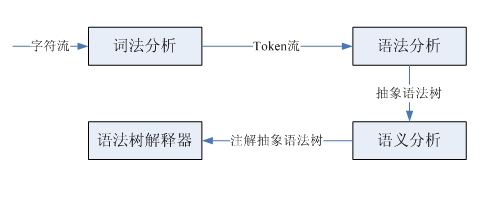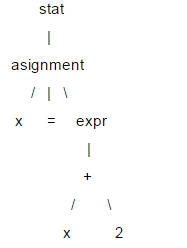一直以来都对编译器和解析器有着很大的兴趣,也很清楚一个编译器的概念和整体的框架,但是对于细节部分却不是很了解。我们编写的程序源代码实际上就是一串字符序列,编译器或者解释器可以直接理解并执行这个字符序列,这看起来实在是太奇妙了。本文会用Python实现一个简单的解析器,用于解释一种小的列表操作语言(类似于python的list)。其实编译器、解释器并不神秘,只要对基本的理论理解之后,实现起来也比较简单(当然,一个产品级的编译器或解释器还是很复杂的)。
这种列表语言支持的操作:
|
1
2
3
4
5
6
7
8
9
10
|
veca = [1, 2, 3] # 列表声明 vecb = [4, 5, 6] print 'veca:', veca # 打印字符串、列表,print expr+ print 'veca * 2:', veca * 2 # 列表与整数乘法 print 'veca + 2:', veca + 2 # 列表与整数加法 print 'veca + vecb:', veca + vecb # 列表加法 print 'veca + [11, 12]:', veca + [11, 12] print 'veca * vecb:', veca * vecb # 列表乘法 print 'veca:', veca print 'vecb:', vecb |
对应输出:
|
1
2
3
4
5
6
7
8
|
veca: [1, 2, 3] veca * 2: [2, 4, 6] veca + 2: [1, 2, 3, 2] veca + vecb: [1, 2, 3, 2, 4, 5, 6] veca + [11, 12]: [1, 2, 3, 2, 11, 12] veca * vecb: [4, 5, 6, 8, 10, 12, 12, 15, 18, 8, 10, 12] veca: [1, 2, 3, 2] vecb: [4, 5, 6] |
编译器和解释器在处理输入字符流时,基本上和人理解句子的方式是一致的。比如:
|
1
|
I love you. |
如果初学英语,首先需要知道各个单词的意思,然后分析各个单词的词性,符合主-谓-宾的结构,这样才能理解这句话的意思。这句话就是一个字符序列,按照词法划分就得到了一个词法单元流,实际上这就是词法分析,完成从字符流到词法单元流的转化。分析词性,确定主谓宾结构,是按照英语的语法识别出这个结构,这就是语法分析,根据输入的词法单元流识别出语法解析树。最后,再结合单词的意思和语法结构最后得出这句话的意思,这就是语义分析。编译器和解释器处理过程类似,但是要略微复杂一些,这里只关注解释器:

我们只是实现一个很简单的小语言,所以不涉及到语法树的生成,以及后续复杂的语义分析。下面我就来看看词法分析和语法分析。
词法分析和语法分析分别由词法解析器和语法解析器完成。这两种解析器具有类似的结构和功能,它们都是以一个输入序列为输入,然后识别出特定的结构。词法解析器从源代码字符流中解析出一个一个的token(词法单元),而语法解析器识别出子结构和词法单元,然后进行一些处理。可以通过LL(1)递归下降解析器实现这两种解析器,这类解析器完成的步骤是:预测子句的类型,调用解析函数匹配该子结构、匹配词法单元,然后按照需要插入代码,执行自定义操作。
这里对LL(1)做简要介绍,语句的结构通常用树型结构表示,称为解析树,LL(1)做语法解析就依赖于解析树。比如:x = x +2;

在这棵树中,像x、=和2这样的叶节点,称为终结节点,其他的叫做非终结节点。LL(1)解析时,不需要创建具体的树型数据结构,可以为每个非终结节点编写解析函数,在遇到相应节点时进行调用,这样就可以通过解析函数的调用序列中(相当于树的遍历)获得解析树的信息。在LL(1)解析时,是按照从根节点到叶节点的顺序执行的,所以这是一个“下降”的过程,而解析函数又可以调用自身,所以是“递归”的,因此LL(1)又叫做递归下降解析器。
LL(1)中两个L都是left-to-right的意思,第一个L表示解析器按从左到右的顺序解析输入内容,第二个L表示在下降过程中,也是按照从左到右的顺序遍历子节点,而1表示根据1个向前看单元做预测。
下面看一下列表小语言的实现,首先是语言的文法,文法用于描述一个语言,算是解析器的设计说明书。
|
1
2
3
4
5
6
7
8
9
10
11
12
|
statlist: stat+ stat: ID '=' expr | 'print' expr (, expr)* expr: multipart ('+' multipart)* | STR multipart: primary ('*' primary)* primary: INT | ID | '[' expr (',', expr)* ']' INT: (1..9)(0..9)* ID: (a..z | A..Z)* STR: (\".*\") | (\'.*\') |
这是用DSL描述的文法,其中大部分概念和正则表达式类似。"a|b"表示a或者b,所有以单引号括起的字符串是关键字,比如:print,=等。大写的单词是词法单元。可以看到这个小语言的文法还是很简单的。有很多解析器生成器可以自动根据文法生成对应的解析器,比如:ANTRL,flex,yacc等,这里采用手写解析器主要是为了理解解析器的原理。下面看一下这个小语言的解释器是如何实现的。
首先是词法解析器,完成字符流到token流的转换。采用LL(1)实现,所以使用1个向前看字符预测匹配的token。对于像INT、ID这样由多个字符组成的词法规则,解析器有一个与之对应的方法。由于语法解析器并不关心空白字符,所以词法解析器在遇到空白字符时直接忽略掉。每个token都有两个属性类型和值,比如整型、标识符类型等,对于整型类型它的值就是该整数。语法解析器需要根据token的类型进行预测,所以词法解析必须返回类型信息。语法解析器以iterator的方式获取token,所以词法解析器实现了next_token方法,以元组方式(type, value)返回下一个token,在没有token的情况时返回EOF。
|
1
2
3
4
5
6
7
8
9
10
11
12
13
14
15
16
17
18
19
20
21
22
23
24
25
26
27
28
29
30
31
32
33
34
35
36
37
38
39
40
41
42
43
44
45
46
47
48
49
50
51
52
53
54
55
56
57
58
59
60
61
62
63
64
65
66
67
68
69
70
71
72
73
74
75
76
77
78
79
80
81
82
83
84
85
86
87
88
89
90
91
92
93
94
95
96
97
98
99
100
101
102
103
104
105
106
107
108
109
110
111
112
113
114
115
116
117
118
119
120
121
122
123
124
125
126
127
128
129
130
131
132
133
134
135
136
137
138
139
140
141
142
143
144
145
146
147
148
149
150
151
152
153
154
155
156
|
''''' A simple lexer of a small vector language. statlist: stat+ stat: ID '=' expr | 'print' expr (, expr)* expr: multipart ('+' multipart)* | STR multipart: primary ('*' primary)* primary: INT | ID | '[' expr (',', expr)* ']' INT: (1..9)(0..9)* ID: (a..z | A..Z)* STR: (\".*\") | (\'.*\') Created on 2012-9-26 @author: bjzllou ''' EOF = -1 # token type COMMA = 'COMMA'EQUAL = 'EQUAL'LBRACK = 'LBRACK'RBRACK = 'RBRACK'TIMES = 'TIMES'ADD = 'ADD'PRINT = 'print'ID = 'ID'INT = 'INT'STR = 'STR' class Veclexer: ''''' LL(1) lexer. It uses only one lookahead char to determine which is next token. For each non-terminal token, it has a rule to handle it. LL(1) is a quit weak parser, it isn't appropriate for the grammar which is left-recursive or ambiguity. For example, the rule 'T: T r' is left recursive. However, it's rather simple and has high performance, and fits simple grammar. ''' def __init__(self, input): self.input = input # current index of the input stream. self.idx = 1 # lookahead char. self.cur_c = input[0] def next_token(self): while self.cur_c != EOF: c = self.cur_c if c.isspace(): self.consume() elif c == '[': self.consume() return (LBRACK, c) elif c == ']': self.consume() return (RBRACK, c) elif c == ',': self.consume() return (COMMA, c) elif c == '=': self.consume() return (EQUAL, c) elif c == '*': self.consume() return (TIMES, c) elif c == '+': self.consume() return (ADD, c) elif c == '\'' or c == '"': return self._string() elif c.isdigit(): return self._int() elif c.isalpha(): t = self._print() return t if t else self._id() else: raise Exception('not support token') return (EOF, 'EOF') def has_next(self): return self.cur_c != EOF def _id(self): n = self.cur_c self.consume() while self.cur_c.isalpha(): n += self.cur_c self.consume() return (ID, n) def _int(self): n = self.cur_c self.consume() while self.cur_c.isdigit(): n += self.cur_c self.consume() return (INT, int(n)) def _print(self): n = self.input[self.idx - 1 : self.idx + 4] if n == 'print': self.idx += 4 self.cur_c = self.input[self.idx] return (PRINT, n) return None def _string(self): quotes_type = self.cur_c self.consume() s = '' while self.cur_c != '\n' and self.cur_c != quotes_type: s += self.cur_c self.consume() if self.cur_c != quotes_type: raise Exception('string quotes is not matched. excepted %s' % quotes_type) self.consume() return (STR, s) def consume(self): if self.idx >= len(self.input): self.cur_c = EOF return self.cur_c = self.input[self.idx] self.idx += 1 if __name__ == '__main__': exp = ''''' veca = [1, 2, 3] print 'veca:', veca print 'veca * 2:', veca * 2 print 'veca + 2:', veca + 2 ''' lex = Veclexer(exp) t = lex.next_token() while t[0] != EOF: print t t = lex.next_token() |
运行这个程序,可以得到源代码:
|
1
2
3
4
|
veca = [1, 2, 3] print 'veca:', veca print 'veca * 2:', veca * 2print 'veca + 2:', veca + 2 |
对应的token序列:
|
1
2
3
4
5
6
7
8
9
10
11
12
13
14
15
16
17
18
19
20
21
22
23
24
25
|
('ID', 'veca') ('EQUAL', '=') ('LBRACK', '[') ('INT', 1) ('COMMA', ',') ('INT', 2) ('COMMA', ',') ('INT', 3) ('RBRACK', ']') ('print', 'print') ('STR', 'veca:') ('COMMA', ',') ('ID', 'veca') ('print', 'print') ('STR', 'veca * 2:') ('COMMA', ',') ('ID', 'veca') ('TIMES', '*') ('INT', 2) ('print', 'print') ('STR', 'veca + 2:') ('COMMA', ',') ('ID', 'veca') ('ADD', '+') ('INT', 2) |
接下来看一下语法解析器的实现。语法解析器的的输入是token流,根据一个向前看词法单元预测匹配的规则。对于每个遇到的非终结符调用对应的解析函数,而终结符(token)则match掉,如果不匹配则表示有语法错误。由于都是使用的LL(1),所以和词法解析器类似, 这里不再赘述。
|
1
2
3
4
5
6
7
8
9
10
11
12
13
14
15
16
17
18
19
20
21
22
23
24
25
26
27
28
29
30
31
32
33
34
35
36
37
38
39
40
41
42
43
44
45
46
47
48
49
50
51
52
53
54
55
56
57
58
59
60
61
62
63
64
65
66
67
68
69
70
71
72
73
74
75
76
77
78
79
80
81
82
83
84
85
86
87
88
89
90
91
92
93
94
95
96
97
98
99
100
101
102
103
104
105
106
107
108
109
110
111
112
113
114
115
116
117
118
119
120
121
122
123
124
125
126
127
128
129
130
131
132
133
134
135
136
137
138
139
140
141
142
143
144
145
146
147
148
149
150
151
152
153
|
''''' A simple parser of a small vector language. statlist: stat+ stat: ID '=' expr | 'print' expr (, expr)* expr: multipart ('+' multipart)* | STR multipart: primary ('*' primary)* primary: INT | ID | '[' expr (',', expr)* ']' INT: (1..9)(0..9)* ID: (a..z | A..Z)* STR: (\".*\") | (\'.*\') example: veca = [1, 2, 3] vecb = veca + 4 # vecb: [1, 2, 3, 4] vecc = veca * 3 # vecc: Created on 2012-9-26 @author: bjzllou '''import veclexer class Vecparser: ''''' LL(1) parser. ''' def __init__(self, lexer): self.lexer = lexer # lookahead token. Based on the lookahead token to choose the parse option. self.cur_token = lexer.next_token() # similar to symbol table, here it's only used to store variables' value self.symtab = {} def statlist(self): while self.lexer.has_next(): self.stat() def stat(self): token_type, token_val = self.cur_token # Asignment if token_type == veclexer.ID: self.consume() # For the terminal token, it only needs to match and consume. # If it's not matched, it means that is a syntax error. self.match(veclexer.EQUAL) # Store the value to symbol table. self.symtab[token_val] = self.expr() # print statement elif token_type == veclexer.PRINT: self.consume() v = str(self.expr()) while self.cur_token[0] == veclexer.COMMA: self.match(veclexer.COMMA) v += ' ' + str(self.expr()) print v else: raise Exception('not support token %s', token_type) def expr(self): token_type, token_val = self.cur_token if token_type == veclexer.STR: self.consume() return token_val else: v = self.multipart() while self.cur_token[0] == veclexer.ADD: self.consume() v1 = self.multipart() if type(v1) == int: v.append(v1) elif type(v1) == list: v = v + v1 return v def multipart(self): v = self.primary() while self.cur_token[0] == veclexer.TIMES: self.consume() v1 = self.primary() if type(v1) == int: v = [x*v1 for x in v] elif type(v1) == list: v = [x*y for x in v for y in v1] return v def primary(self): token_type = self.cur_token[0] token_val = self.cur_token[1] # int if token_type == veclexer.INT: self.consume() return token_val # variables reference elif token_type == veclexer.ID: self.consume() if token_val in self.symtab: return self.symtab[token_val] else: raise Exception('undefined variable %s' % token_val) # parse list elif token_type == veclexer.LBRACK: self.match(veclexer.LBRACK) v = [self.expr()] while self.cur_token[0] == veclexer.COMMA: self.match(veclexer.COMMA) v.append(self.expr()) self.match(veclexer.RBRACK) return v def consume(self): self.cur_token = self.lexer.next_token() def match(self, token_type): if self.cur_token[0] == token_type: self.consume() return True raise Exception('expecting %s; found %s' % (token_type, self.cur_token[0])) if __name__ == '__main__': prog = ''''' veca = [1, 2, 3] vecb = [4, 5, 6] print 'veca:', veca print 'veca * 2:', veca * 2 print 'veca + 2:', veca + 2 print 'veca + vecb:', veca + vecb print 'veca + [11, 12]:', veca + [11, 12] print 'veca * vecb:', veca * vecb print 'veca:', veca print 'vecb:', vecb ''' lex = veclexer.Veclexer(prog) parser = Vecparser(lex) parser.statlist() |
运行代码便会得到之前介绍中的输出内容。这个解释器极其简陋,只实现了基本的表达式操作,所以不需要构建语法树。如果要为列表语言添加控制结构,就必须实现语法树,在语法树的基础上去解释执行。










